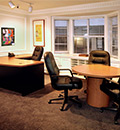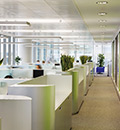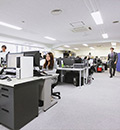Center for Contemporary Art of Montenegro
The Center for Contemporary Art of Montenegro is one of the most important cultural institutions of the country, located in its capital,
Podgorica. Founded in 1995, the gallery is sheltered within the monumental Petrovic Castle. The Center’s permanent collection includes a
unique and international selection of over 1,000 artworks from 60 different countries, broken up into four collections: African, Asian,
Latin-American and European art. Nowhere else in south-eastern Europe can you find such a showcase of important and diverse works as at
the Center for Contemporary Art of Montenegro. There are also two smaller galleries that belong to the Center, the Perjanicki Dom and the
Centar, which are used for specific exhibitions and cultural events.
Montenegrin Gallery of Arts: Miodrag Dado Djuric
The Miodrag Dado Djuric art gallery was opened in Cetinje only a short time ago, in 2012, but it will certainly play a major role in the
promotion of Montenegrin art internationally: it is the biggest art gallery in Montenegro, with a 1,600 square-metre exhibition space
distributed over four floors, and presents works by contemporary artists created between the first half of the 20th century and today.
The gallery can be found in one of the tallest and most modern buildings of the city, and is named after Miodrag Djuric, a great Yugoslav
painter better known by the nickname Dado.
Pizana Gallery
Founded in the 1990s, Pizana Gallery exhibits works by young Montenegrin artists who express their vision in different forms, including
painting (Tadija Janičić, Milena Durutović, Milka Vujović), graphics (Biljana Keković, igor Rakčević) and sculpture (Željko Reljić, Ivanka
Prelević-Vana), or a combination of these; but exhibitions of major artists such as Salvador Dali and Andy Warhol have been presented in
the past as well. The gallery has acted as a creative hub and starting point for a range of cultural initiatives, and keeps itself busy by
presenting the works of its artists in local and international art fairs. Pizana gallery has two different exhibition spaces in Montenegro:
a 200 square-meter one in the capital, Podgorica; and another in the smaller city of Tivat.
Josip Bepo Benkovic Gallery
The Josip Bepo Benkovic art gallery is located in Herceg-Novi, a beautiful coastal town at the entrance to the bay of Kotor. The gallery
has an exhibition space of 100 square-meters, and holds a permanent collection of over 200 pieces – paintings, sculptures and prints.
Although individual exhibitions are often held, the Josip Bepo Bekovic gallery is particularly renowned for the Winter Salon, an annual
initiative started in 1967, which presents works from different artists collectively. Initially, the Winter Salon only showcased the works
of Yugoslav artists, but as its prestige grew, international artists began to participate as well. One of the gallery’s rooms is dedicated
to the memory and works of Joisp Bepo Benkovic, a Yugoslav artist executed in 1943 after whom the gallery is named. A special collection of
50 images by painter Milene Sotre is also on view.
Modern Gallery
The Modern Gallery of Budva is a museum of modern and contemporary art. It was founded in 1972, and since the first exhibition held that
year, all the exhibited artists have donated at least one piece to the institution. In fact, Budva’s Modern Gallery has accumulated the
whole of its current collection in this manner, and only rarely purchases art. Today, the Modern Gallery possesses about four hundred art
pieces, grouped into five separate collections: the Collection of Contemporary Expressionists, the International Fine Art Collection, the
National Art Collection, the Collection of Local Artists and the Naïve Art Collection. The featured artists include many respected Yugoslav
figures, such as Nikola Graovac, Milan Konjović, Ljuba Popovic and Olja Ivanjicki.
Most Gallery
In Serbian, ‘most’ means bridge. The name is certainly fitting, as this contemporary art gallery located in Podgorica acts as a bridge
between different art forms and artists. Over the almost twenty years that have passed since its foundation in 1994, the gallery has
presented more than 300 individual and collective exhibitions, including ones of prominent Yugoslav artists such as Dado Djuric and Dimitrije
Popovic. But around the art exhibitions, which remain at the core of Most’s activity, a whole cultural centre was built, a place where
painting and sculpture can dialogue with other arts such as cinema, theatre and multimedia, and that contributes to the promotion of the arts
through events and publications.







